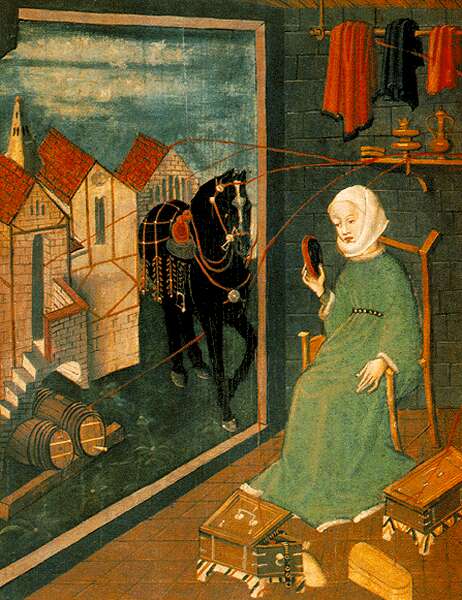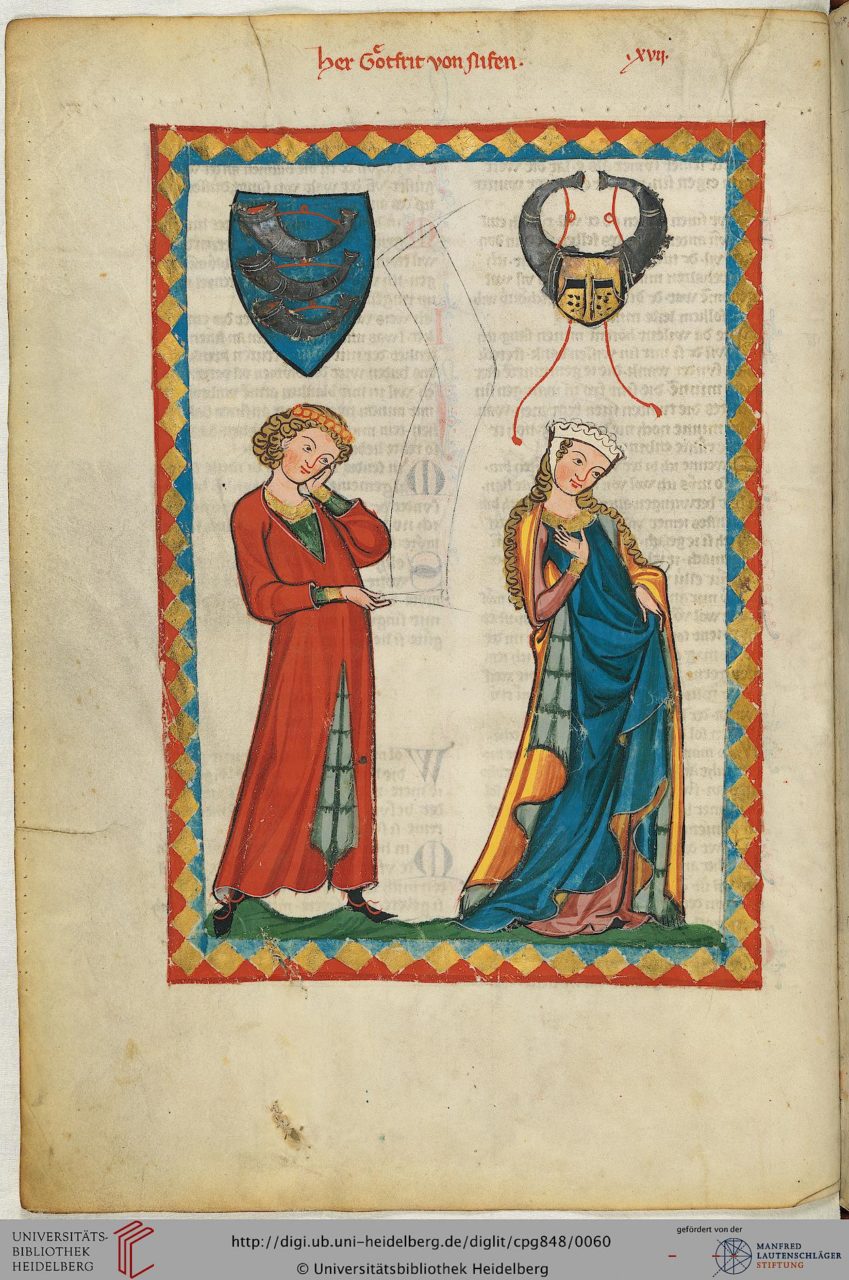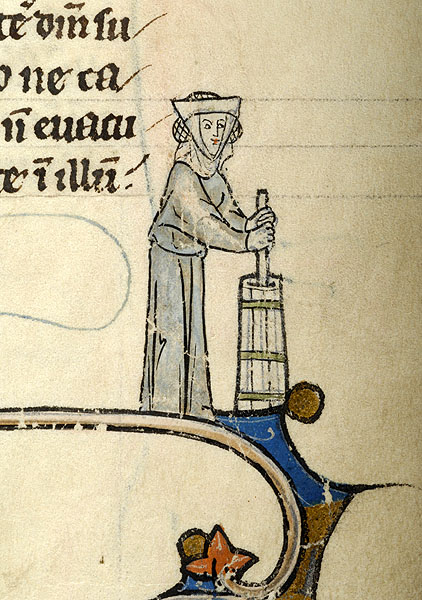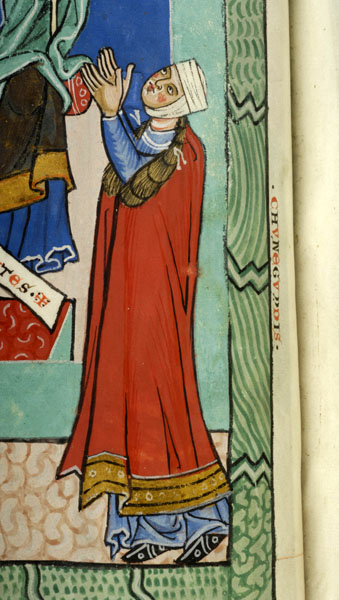A piece of linen which passes under the chin and is pinned at the sides, usually worn in conjunction with additional head coverings during the Middle Ages.
V alerie Cumming and C.W. and P.E. Cunnington describe the barbette as a women’s garment worn in the period of 1200-1350 CE in The Dictionary of Fashion History (2010):
“A French term for the wimple and also for the linen band worn under the chin and pinned on the top or sides of head; usually worn with a white fillet.” (20)
For ‘wimple’, they write:
“Late 12th to mid-14th centuries, rare in the 15th century. A long piece of white linen or silk draped over the front of the neck and swathed round the chin, the ends being pinned to the hair above the ears. It was worn with a veil or fillet or both, or sometimes alone.” (294)
So the barbette is most clearly defined as the secured linen band under the chin. Figure 1 depicts a woman wearing a barbette in this way in an image from the 15th century. She is wearing a headcloth with it in order to fully cover her hair. The French word barbe means beard, so the band worn by women resembles a female beard, thus a “barbette.”
Phyllis Tortora and Sara B. Marcketti describe how the barbette is worn in their Survey of Historic Costume (2015):
“Most women covered their hair entirely and wrapped veils so closely that only the face showed. A linen band – barbette – passed down from the temple under the chin and up to the other, called a fillet, rather like a crown.” (134)
An illumination from a medieval manuscript depicts a woman wearing a fillet on top with a barbette circling under her chin, with her hair left loose underneath (Fig. 2). Daniel Delis Hill describes the head-dressing of upper-class women in the early middle ages in his History of World Costume and Fashion (2011):
“At the end of the twelfth century, women began to arrange layers of veils over circlets or small toques to more fully cover the hair. A linen band called a barbette was attached to the headdress and fixed under the chin to hold the arrangement in place.” (324)
Figure 3 is a margin drawing showing a woman churning butter and wearing a barbette and fillet – clearly, it was not just noblewomen taking part in this style. The class differences would have been apparent through the quality of the linen worn; a noblewoman of means would have had an extremely fine, almost transparent barbette, and a working woman like this would have had something thicker and more coarsely woven. Her hair is covered by a complex caul.
In The Complete Costume Dictionary (2011), Elizabeth and Dan Lewandowski give a definition for the barbe, and direct the reader to it from ‘barbette’:
“Byzantine and Romanesque (400-1200 CE) piece of fabric, often linen. Worn under the chin. Commonly worn by widows or persons in mourning.” (23)
The Lewandowskis also note a term or garment that succeeded ‘barbette’:
“gorget: Early Gothic (1200-1350 C.E.). Piece of linen or silk that was worn by women draped over chin, neck, and shoulders and then pinned to hair on sides of face. Replaced the barbette.” (123)
In figure 4, an illumination from the 13th century shows a woman wearing a barbette and fillet that completely cover her hair. In figure 5, a married noblewoman is depicted wearing a barbette with her fillet and crown, with her hair braided underneath and hanging down her back.
Fig. 5 - The Naumburg Master (German). Countess Gerburg von Brehna, ca. 1250. Stone. Germany: Naumburg Cathedral. Source: Pinterest
Fig. 1 - Artist unknown (Possibly Austrian). Evagationes Spiritus (The erring of the soul), 1430s. Tempera on wood; 58 x 46 cm. Budapest: Esztergom Christian Museum, Inv. 56.495. Source: Hungarian Christian Museum
Fig. 2 - Herr Gottfried von Neifen (German, died 1279). Große Heidelberger Liederhandschrift (Codex Manesse), 1320. Manuscript on parchment; 35 x 25 cm. Zürich: Bibliotheca Palatina, Codices Palatini Germanici 848, folio 32v. Source: University Library Heidelberg
Fig. 3 - Artist unknown (Northeastern France). Bible: Beginning of Ecclesiasticus, 1275-1299. New York: The Morgan Library & Museum, MS M.969 fol. 253r. Purchased on the Fellows Fund, 1976. Source: The Morgan Library
Fig. 4 - Artist unknown (Austrian, probably from the monastery of Seitenstetten). Gospel Book: CHVNEGVNDIS, 1225-1275. New York: The Morgan Library & Museum, MS M.808, fol. 29v.. Purchased in 1940. Source: The Morgan Library
References:
- Cumming, Valerie, C.W. Cunnington and P.E. Cunnington. The Dictionary of Fashion History. New York: Berg, 2010. Link.
- Hill, Daniel Delis. History of World Costume and Fashion. Upper Saddle River, NJ: Pearson Prentice Hall, 2011. http://www.worldcat.org/oclc/939043732.
- Lewandowski, Elizabeth J. The Complete Costume Dictionary. Lanham, MD: Scarecrow Press, 2011. http://www.worldcat.org/oclc/694238143.
- Norris, Herbert. Medieval Costume and Fashion. New York: Dover Publications, 1999. http://www.worldcat.org/oclc/987785495.
- Tortora, Phyllis G., and Sara B. Marcketti. Survey of Historic Costume. Sixth edition. New York: Fairchild Books, 2015. http://www.worldcat.org/oclc/910929404.














